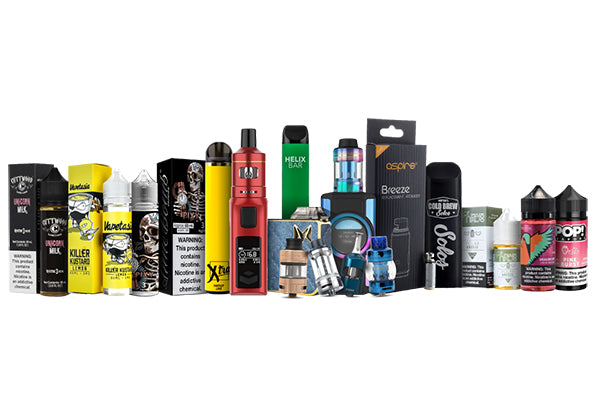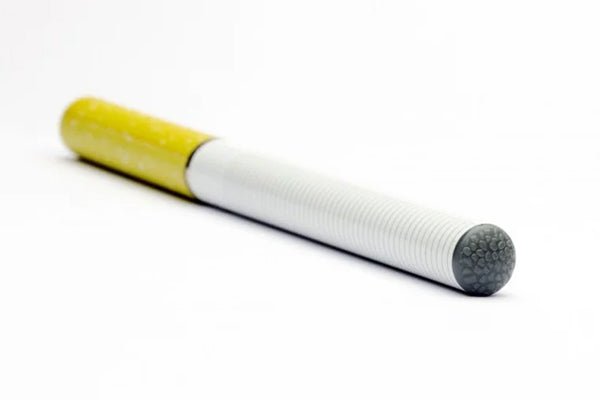History of Vaping
What is Vaping?
Vaping is defined as the consumption of nicotine through an alternative nicotine product that requires a device composed of a battery, tank, coil, and eJuice. The eJuice is vaporized through the heating of a coil in the vaping device. Hardware can range from an all-in-one (AIO) setup, you can mix and match hardware and eJuice, or use disposable vape devices containing pre-filled vape liquid. Vape juice lasts about a year and most vapers vape either 3 mg or 6 mg strengths of nicotine from 60 ml, 100 ml, or 120 ml bottles.
As an alternative nicotine product, the cost of vaping is generally considered cheaper in the long run than traditional nicotine products. It depends on how much you vape over a period of time. You can buy any vape product from a vape store nearby, or you can purchase them from legitimate online retailers such as eJuices.com/eLiquid.com. There are many ways to vape out there, so mix and match to try out different vaping experiences!
Jump to:
History of Vaping Vaping Popularity Vape Juice Vaping Devices Vape Juice Legislation Vaping FAQIntroduction to the History of Vaping
Believe it or not, vaping has been around longer than you think. The Greek historian Herodotus recorded as early as the fifth century BC that people heated herbs and oils on hot stones as one of the first mentions of vaping. By the fifth century, Irfan Shiekh invented the shisha in Afghanistan. This device eventually made its way to India. By 1927, American inventor Joseph Robinson came up with the idea of an e-cigarette, although it was never brought to market; the only evidence for this is the U.S. Patent 1,775,947. Herbert Gilbert built on this idea in the 1960s and invented the “smokeless non-tobacco cigarette” in 1963.
The first modern e-cigarette as we know it today was invented by Chinese pharmacist Hon Lik in 2006. His employer at the time, the Ruyan Group, spread his invention to Europe, and eventually, the e-cig as we know it came to the United States by 2007. Vaping in its present form has reached every continent on Earth.
What Made Vaping So Popular?

Vaping was introduced as a method of reducing reliance on traditional nicotine products. The first vape products appeared in the United States around 2007. However, vaping giant Juul accelerated the popularity of vaping in 2017. In 2017, over half of the e-cigarette market was controlled by Juul. Smaller vaping companies also wanted to get into the market, creating both vape juices and hardware.
Due to the rise in popularity of vaping and youth consumption of vape products, there have been various regulations and legislation enacted against vaping, such as the banning of new flavors after August 8, 2016, as well as flavor bans in states such as New York, Massachusetts, and localities such as San Francisco, California.
Types of Vape Juice

There are many types of vape juice that you can purchase at a vape shop nearby, or from legitimate online retailers such as eLiquid.com. There are numerous categories of vape juice and vape juice flavors. Fruit and dessert vape juice flavors are two of the most popular flavor categories today.
Some of the most popular fruit flavored vape juices include strawberry, mango, raspberry, banana, and others, while some of the most popular dessert flavored vape juices include cheesecake, ice cream, cookies, among others. Other popular types of vape juice include traditional flavors such as tobacco and menthol, as well as nicotine salt vape juices for those who prefer higher nicotine content in their vaping experiences.
When vaping first came to the United States, tobacco flavors were the first flavor. It is unknown who was the first to offer flavors outside of the traditional tobacco and menthol, but Juul was the first company to popularize vape juice flavors such as mint and fruity flavors. As previously mentioned, some of the top flavors include fruit flavors and dessert flavors, although coffee flavor vape juice has become popular among vapers in recent years.
First-time vapers and vapers who prefer more nicotine in their vape juices tend to vape nicotine salts. These generally come in 25, 35, or 50 mg nicotine strengths, making these more potent and thus vapers have to take fewer hits. Disposable devices also use nicotine salts. You can find some great disposable devices and nicotine salts on eLiquid.com.
Some popular brands include Beard Vape Co., Time Bomb Vapors, and Aqua eJuice. These are some of the best vape juice brands selling on the market today. There are many other vape juice brands available on eLiquid.com as well. Both have fruit and dessert offerings that are best sellers such as Beard Vape Co. - #32 Cinnamon Funnel Cake, Time Bomb Vapors - TNT, and Aqua eJuice - Pure. These vape juice flavors are just some of the most common and popular eJuice brands that you can find in your local vape shop or on online retailers such as eJuices.com/eLiquid.com.
On eLiquid.com, we have thousands of vape juices available for purchase at affordable prices. eeLiquid.com has thousands of vaping products in stock that ship the same day, and we seek to provide the best customer experience possible when it comes to purchasing vape products. You can even earn rewards points when you shop with eLiquid.com, adding value to each purchase you make!
Evolution of Vaping Devices
First Generation Vape Products

As we previously mentioned, e-cigs have been around in the United States since 2007. The first generation of e-cigs is Hon Lik’s Ruyan e-cigarette, or the cig-a-like. This was called a cartomizer and utilized three pieces: the flavor cartridge, the atomizer, and the battery (hence the name cartomizer). This was also the first e-cig to use resistance wiring wrapped around cotton. This would serve as the first development of coils that vapers use in their devices today.
Second Generation Vape Products

The second generation of vaping devices is the vape pen. The vape pen is popular among those who are new to vaping as this requires no setup. The vape pen is also known as a clearomizer and is also a closed system vape device. One could control the battery through an on/off button and use it as a firing switch, as opposed to cartomizers which fired upon inhalation. One of the major brands at this time was ProVape, which was also one of the first American-made vaping devices. This was later followed by the ProVari, which boasted a superior build and battery life but also came at a premium price of around $200. What doomed the ProVari though was its low wattage, which would be addressed in the third generation of vaping devices.
Third Generation Vape Products

The third generation of vaping devices are also known as vape mods. These are the current versions of vape devices, although disposable vapes fall under the second generation of vaping devices. These vape mods include the mod itself, a tank, and a coil. Some major manufacturers of vaping devices and vape coils include GeekVape, FreeMax, SMOK, Voopoo, Vaporesso, Aspire, and more. These manufacturers create mods, tanks, and coils. You can mix and match any way you want—vaping is personal, so try out any combination of these devices and find something that works for your personal vaping experience(s).
Legislation Behind Vaping Hardware and Vape Juice
One of the most important pieces of vape regulation is the FDA’s Deeming Rule, which stated that any vape juices made after August 8, 2016 cannot be sold on the market. Last year was the premarket tobacco application (PMTA) deadline of September 9, 2020, which required all vape manufacturers to submit their products to the FDA for review and approval to be sold on the market. Both vaping hardware and vape juice are subject to legislation by the FDA.
As of March 27, 2021, the PACT Act will prohibit the USPS from shipping vape products to retail customers. Private shippers such as FedEx, DHL, and UPS have also banned the shipping of vape products, further reducing access for retail customers in 2021.

Vaping by State
Individual states have taken action against vape as well, either through taxes on wholesale vaping products or flavor bans. Some have left it up to the voters to decide on whether or not there should be flavor bans, such as California. Voters sent the flavor ban to referendum recently. This ban was supposed to take place on January 1, 2021, but California voters will decide on the November 2022 ballot whether or not to ban flavors.

Vaping Internationally
Some countries have taken especially harsh steps towards the vaping industry. China has banned online sales, while countries such as South Africa, the Philippines, and Qatar have partially or totally banned any sale of vaping products in their countries. Panama has had a ban on e-cigarettes since 2009. However, enforcement varies by jurisdiction and the act of vaping itself continues internationally.
Europe is the most friendly towards the sale of vape juice, with sales of vape products containing nicotine legal in almost every EU member country. As of this writing, Belgium, the United Kingdom, and Estonia have placed caps on nicotine content in eJuice.
Frequently Asked Questions About Vape
Is vaping bad for me?
While vaping has its risks just like any other activity, studies are still being conducted on whether or not vaping is an acceptable method of harm reduction. Some countries have already accepted that vaping flavored vape juices is a form of harm reduction.
Is the United States government going to ban vaping?
As of this writing, the act of vaping is not outlawed in any state or locality, although there are restrictions on buying vape products in certain cities and states. It is highly unlikely that vaping will be banned.
Is vaping expensive?
Most vape juices retail for as little as $5 but can cost as much as $30. From an economic standpoint, vaping is one of the cheaper alternative nicotine products. However, this may change in the near future as states and the federal government look to tax vaping products. Some states have already implemented taxes on vaping products.
What is in vape juice?
There are several ingredients in vape juice: vegetable glycerin (VG), propylene glycol (PG), nicotine, water, and flavorings.
Is vape juice regulated?
The Food and Drug Administration (FDA) through the Center for Tobacco Products (CTP) regulates the vaping industry.
